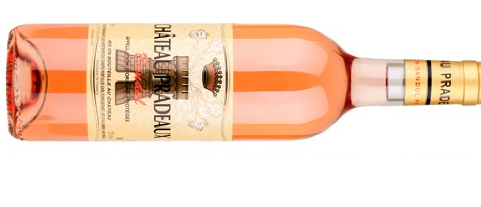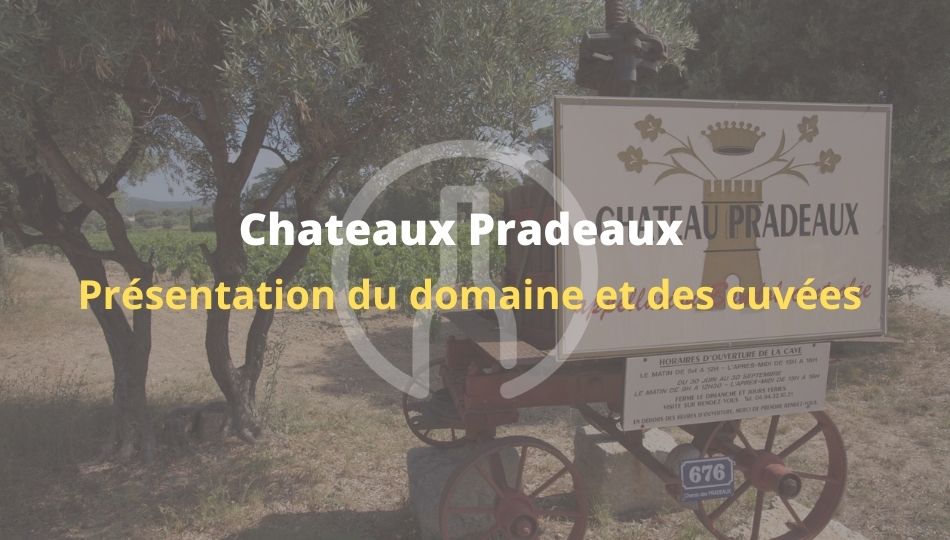Today, we're going to introduce you to one of our partner estates: Châteaux Pradeaux.
History of the domain :
Since 1752, the famous Châteaux Pradeaux has been owned by the Portalis family. Jean-Marie Etienne Portalis, co-editor of the Civil Code and negotiator of the Concordat under Napoleon 1, inherited the property in the same year. During 1789, the property was destroyed by the Revolution, and again during the Second World War. The château was later restored to its former glory thanks to the hard work of Arlette Portalis and her mother Suzanne. Cyril Portalis, who took over the reins of the Château from his aunt, now runs it in a traditional style. This former vineyard did not produce sufficient yields. It is best known for its red wines, which are very slow to open and have a long ageing potential. The estate extends over 22 hectares of vines on an amphitheatrical clay-limestone terroir facing the sea, 20 hectares of which are in the Bandol appellation.
Part of the Bandol appellation, this château refers to a place formerly covered by marshes, but the archives that were dissipated during the revolutionary period rule out any idea of verifying this supposition. The estate also produces Côte de Provence and Vin des Pays wines. Racy reds and splendid rosés are produced on this estate with an unforgettable history.
During the 39-45 war, Arlette Portalis, accompanied by her mother Suzanne, moved to the estate and renovated the property, which had once been destroyed by the occupying forces. With the help of Baron Leroy, founder of the INAO, they became part of the Bandol and Mourvèdre adventure. Arlette passed on her passion for Bandol to Cyrille, her only descendant. Since 1985, he has been the sole winemaker at Château Pradeaux and the only one to nurture his passion for Mourvèdre and its patient ageing in oak tuns. Later, he passed on his passion for Mourvèdre to his two sons, Etienne and Edouard. Edouard works with his father, and Etienne eventually joins them. The château is still run today by Portalis' current descendants.
The estate today :
Cyrille Portalis has been assisted by his son Etienne since 2011. Etienne Portalis is a young ISARA engineering graduate who has just arrived on the harvesting side of the business. He becomes the vineyard manager and is responsible for marketing the wines. He guides the wines towards greater finesse and tension. Together, Cyrille and Etienne have a very traditional vision of Bandol. Bandol wines don't reveal themselves easily when they're young, but their potential eventually comes to the fore. In comparison with other Bandol wines, such as Domaine Tempier or La Bégude, Pradeaux wines are outstripped by more modern, colorful, oaky cuvées that are easy to enjoy when young. Pradeaux remains a very classic red wine, with power and uniqueness thanks to very long vinification and ageing, up to 48 months in old foudres aged between 40 and 80 years. Despite cellaring for up to 10 years, these wines will continue to surprise. From 2015 onwards, the wines' sanguine temperament begins to deliver itself with ardor. The airs of Piedmont's Niebbiolo give it a certain sincerity. This wine is planted on 18 hectares and harvested by hand. The average age of the vines is 40 years, and the most commonly used red grape varieties are: Cinsault 5 %, Grenache noire 15 % and Mourvèdre 80 %. Bandol currently produces 80 % of rosé wines, and Etienne Portalis, who now owns Château de Pradeaux, is fighting for recognition of the red wines. For him, the Bandol brand is red, even if the current trend is more towards rosé. In 20 years, production has evolved from 80 % of red wine to 80 % of rosé.
The great vintages of Château Pradeaux :
-
Château Pradeaux Rouge :
This is the estate's representative cuvée. This wine is composed of 95 % of Mourvèdre and 5 % of Grenache. The grapes are hand-picked late in the year, between September and early October. The grapes are vinified as whole bunches, and must reach a good level of ripeness to ensure that the pips and stalks are just right. The wine is aged for 3 to 4 years in oak foudres before bottling. This is a wine for laying down that needs to wait ten years or so before opening up fully and giving free rein to the tasting. The color is dark garnet with purplish highlights. On the nose, notes of black fruit, coffee, roasting and licorice. On the palate, notes of truffles and cocoa. It goes well with tasty meats such as game, duck breast or prime rib.
-
Château Pradeaux Rosé :

It's a blend of 50 % Mourvèdre and 50 % Cinsault. Direct pressing, aged in vats. This is a gastronomic rosé, demanding and vinous, with a lively, bright salmon color. Rosy on the palate, it's vinous and slightly closed if enjoyed straight away. It needs time to open up, due to the Mourvèdre grape, and requires 4 to 5 months of waiting before being consumed fresh, but not chilled. It goes well with tian, zucchini flans with basil and fish dishes.
We hope you've enjoyed this article, and look out for our other articles on our partner estates. See also our Château Pradeaux wines in stock on the site!








